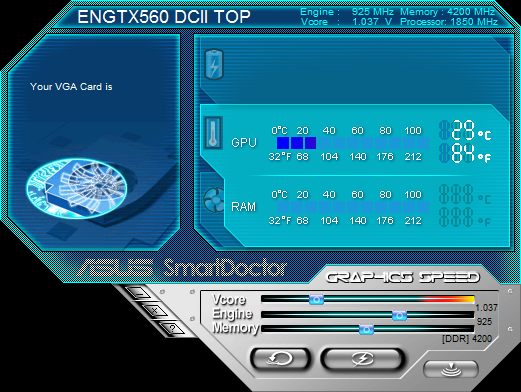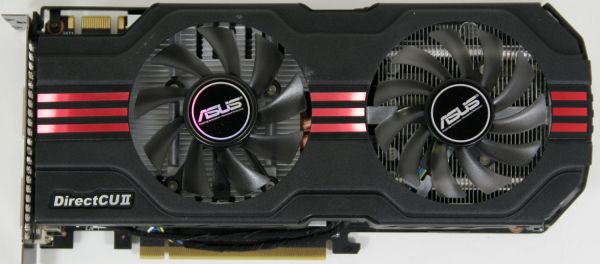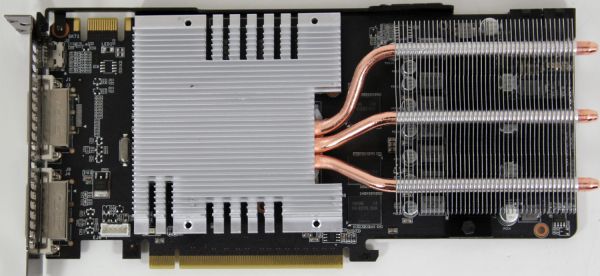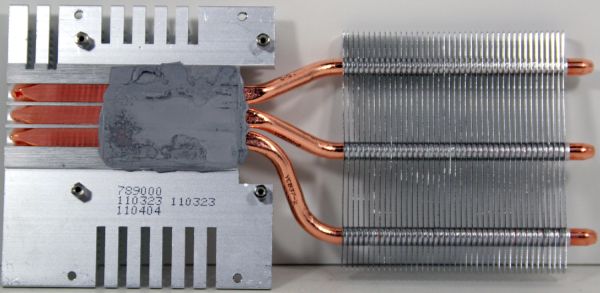NVIDIA's GeForce GTX 560: The Top To Bottom Factory Overclock
by Ryan Smith on May 17, 2011 9:00 AM ESTMeet ASUS’s GTX 560 DirectCU II Top
As we mentioned previously, the card we’re sampling today is ASUS’s GTX 560 DirectCU II Top, the faster of ASUS’s two GTX 560s, and the 2nd fastest card on NVIDIA’s launch list. It’s clocked at 925MHz for the core and 4200MHz (data rate) for the memory, giving it a sizable 115MHz (14%) core clock and 196MHz (5%) memory clock advantage over the GTX 560’s reference clocks. As we’ll see when we get to benchmarking, this is fast enough to start challenging reference clocked GTX 560 Tis.
We’ve reviewed a number of ASUS DirectCU cards in the past, but this is the first card we’ve reviewed from them that uses the DirectCU II cooler. What’s the difference? The DirectCU (I) was an open air cooler with single fan mounted at the center of the card; the DirectCU II uses two 80mm fans. In practice it’s similar to some previous coolers we’ve seen such as MSI’s Twin Frozr, however ASUS has managed to throw in their own unique adjustments.
Notably, the DirectCU II uses a different fan configuration than what we normally see with these dual-fan cards. Normally these cards are symmetrical – the left and right fans are the same. In the case of the DirectCU II ASUS is using different fans, with the left side using a taller 9 blade fan while the right side uses a more typical shorter 11 blade fan. ASUS hasn’t specifically mentioned why they do this – we’d assume they found it more efficient – but it’s an interesting deviation from what we normally see with this style of a cooler.
Removing the shroud and fans, we’re down to the actual HSF the cooler uses. ASUS has ditched the two large aluminum heatpipes running across the top of the card for a trio of smaller copper heatpipes running directly from the base of the HSF to the secondary heatsink over the rear of the card. These dual aluminum heatsink configurations are typical for dual-fan cards. Flipping the HSF over and we can see the base of the unit; ASUS has the heatpipes make direct contact with the GPU rather than using a baseplate to spread the heat out some. Both the heatpipes and the primary heatsink end up making contact with the GPU as a result.
Cooling for the VRMs is provided by small spring-loaded heatsinks attached directly to the MOSFETs. The airflow from the fans provides cooling for these heatsinks, along with some airflow over the GDDR5 memory modules to keep the card’s RAM cool.
Overall the build quality of the GTX 560 DirectCU II is up to the same solid standards we see out of an ASUS DirectCU card. ASUS continues to be the only manufacturer we see regularly using stiffening brackets with an open air cooler, making the card extremely rigid and almost impossible to flex. Even the shroud is surprisingly durable, having apparently been coated in some kind of metal or metal-like rigid plastic.
Moving on, with the factory overclock power consumption is undoubtedly higher than NVIDIA’s reference value of 150W. ASUS and other video card manufacturers don’t normally provide a TDP for the card, but we’d guess it’s around 170W, similar to that of the reference GTX 560 Ti. Providing this power is a pair of PCIe power sockets, which ASUS has helpfully oriented at the top of the card rather than the rear as we’ve seen on most other GTX 560/460 cards.
As is normally the case with ASUS DirectCU cards, the tradeoff in their design is that their cards are a bit bigger on average. Like the DirectCU (I), ASUS’ shroud is longer than the PCB itself, so while the PCB is only around 9.15” the total length of the card is just over 9.8”, versus 9” for the reference GTX 560 Ti. Meanwhile for display outputs, ASUS is following the typical NVIDIA design: 2x DVI ports and a single mini-HDMI port.
Rounding out the package, ASUS includes their usual collection of utilities: GamerOSD and SmartDoctor. SmartDoctor hasn’t changed since the last time we’ve looked at it; it still provides a passible but ultimately dated GUI for monitoring and overclocking the card. ASUS is offering voltage tweaking on this card for overclockers looking to push the card higher than 925MHz, so overvolting through SmartDoctor is a necessity for getting much farther than 925MHz. A good GF114 GPU should be able to hit near 1GHz with some extra voltage, though in our case we were only able to push our card to 950MHz, even at 1.075v.

The rest of the collection is your usual pack-in fare: a multi-language quick setup guide, a mini-HDMI to HDMI dongle, 2 molex-to-PCIe power adapters, and a DVI-to-VGA dongle.
Finally, as the GTX 560 DirectCU II Top is ASUS’s top-tier GTX 560, it also has a top-tier price: ASUS is charging an additional $20 over the GTX 560 OC, for an MSRP of $219.














66 Comments
View All Comments
Ryan Smith - Tuesday, May 17, 2011 - link
In this case we only had the single card.buildingblock - Tuesday, May 17, 2011 - link
My local hardware dealer has the new 560 (non-Ti) in stock today. True, only two models so far but the cheapest 560 in stock costs less than the cheapest 6870 in stock, and even less than some of the 6850s. And that's the issue, graphics cards are about price points. Its no good going on about the AMD 6950 to buyers who are only looking at choosing either a 560 or a 6870, because both are around the same price point. And as already said, the 560 today is actually at a better price point at this dealer than any 6870.One reason why the majority of discrete desktop graphics card buyers continue to purchase nVidia is the quality of the drivers. Or the continuing issues with AMD drivers. There is an example here http://forum.team-mediaportal.com/746244-post1.htm... of a guy who's having problems rendering a web page with a 6950. Yes, that's right a web page, now don't going playing games with it will you.... What he is seeing is partly because the page has a Shockwave slideshow. He complains that GPU usage constantly fluctuates between 0-8-18-44%, with a 6950. With a GTX 550 Ti GPU usage figures 0-2-11% - that's right only 11% with a GTX 550 Ti compared to 44% with an AMD 6950.
That's AMD drivers for you.
DanNeely - Tuesday, May 17, 2011 - link
Meh. That's not a real issue, as can be seen by the replies. Following up on it I'd speculate that the only reason the single time sample spikes at high load are spotted at 175mhz but not at 450 is that at the latter the render takes significantly less than the sample time so they get largely smoothed into the average (as can be seen by the smaller load spikes).There is one real issue in their drivers that's been annoying me significantly since I got my 5870 last summer. When running 2 monitors and a GPU app, when the app completes a work unit it drops down to single monitor speed for a second or three and ghost images from the top of one monitor flicker on the 2nd until the new task starts and the clocks throttle back up. I've made it go away by creating a profile and manually editing its config file so that the single monitor settings (which it enters despite 2 attached monitors) are no lower than the others. This makes the problem go away, but really...
ratbert1 - Tuesday, May 17, 2011 - link
I suggest reading more than one review before deciding which card is better. I do not get the same results as Anandtech does on the same benchmarks. I have a different platform and get different results. Their bench is useful for getting a rough idea, but there are a lot of other sites to check. Not all show the same AMD scores gotten here.I have tried to use AMD cards in the past. I really have, but with a 5850 I could not get it to work with a DVI connection, and with a 3450 it would bluescreen whenever I played a DVD. Both were sent back. All the other cards I have had (Nvidia) just worked!
I even recently looked at getting a 6950, but too many comments on Newegg were about the lousy drivers(too many for me anyway). I just couldn't do it.
L. - Wednesday, May 18, 2011 - link
Well, there's a fair chance your local hardware dealer sucks, as do all local hardware dealers.Get on the web man, its 2011.
At least you'll get to choose your brand and model for realz ;)
jiffylube1024 - Tuesday, May 17, 2011 - link
The GTX 460, ATI 6850 and 6870 are all still quite solid cards, and these charts prove it. Anyone with a GTX 460 (1GB) that overclocked it to 800-850 MHz basically has a GTX 560.It's nice to see the GTX 560 pushing the GTX 560 series at/under $200.
-----
I'm impressed with how much the 6870 has improved versus the 5870. When the 6870 came out, it was basically trumped by the 5870 in everything; now, if anything, the 6870 comes out a bit faster.
marc1000 - Tuesday, May 17, 2011 - link
you meant "The GTX 460, ATI 5850 and 5870 are all still quite solid cards"?because 6850 and 6870 are current-gen....
marc1000 - Tuesday, May 17, 2011 - link
Now I can not say to a friend "buy the GTX 560" when he asks if this card if better or equal to R6950. because he will probably buy the cheapest one, wich will have the SAME name, but is slower.ATI/AMD naming is bad, but Nvidia is worse!
LOL_Wut_Axel - Tuesday, May 17, 2011 - link
I don't know where you guys are getting this information, but the Radeon HD 6870 IS NOT at $180. Therefore, you shouldn't let that sway your opinion about this card. The Radeon HD 6870 is a $200 card, as is the GTX 560. Folders and gamers should go for the GTX 560, while people that want higher efficiency and same performance should go for the Radeon HD 6870.That alone leaves me with a very bad taste about this article. I suggest you read the review by Tom's Hardware and TechPowerUp instead.
starfalcon - Tuesday, May 17, 2011 - link
A 6870 can hit $170 on Newegg with a rebate, but $192 or so does seem to be the lowest without any rebates.